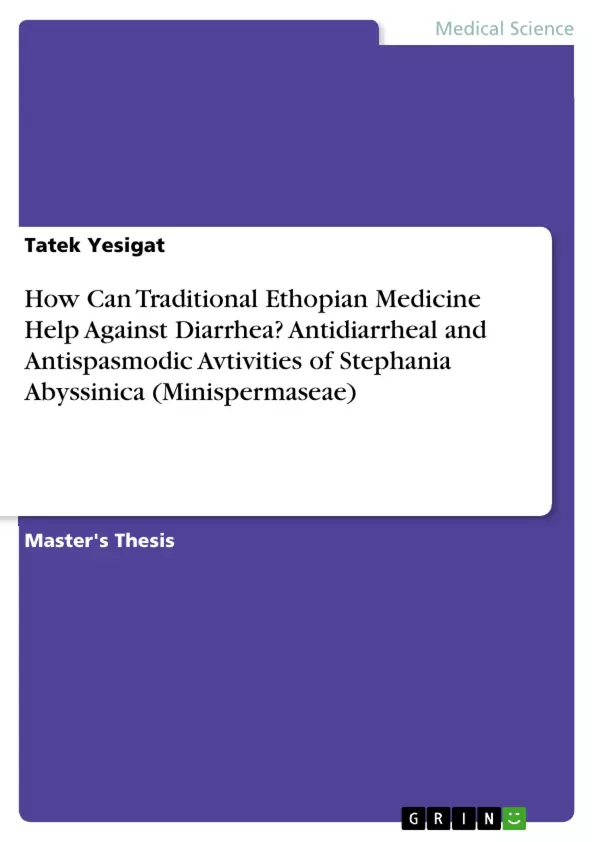Diarrhea is a leading cause of morbidity and mortality in developing countries. The aim of this work was therefore to evaluate the antidiarrheal and antispasmodic activities ofthe aqueous and methanol extract of the root and leaf of S. abyssinica.
Antidiarrheal activities were studied in mice using castor oil-induced diarrhea at doses of 25, 50,100, and 200 mg/kg body weight. The extracts significantly prolonged the time of diarrheal induction, increased diarrhea free time, reduced the frequency of diarrhea episodes, decreased the weight of stool, and decreased general diarrheal score in a dose dependent way. With dose of 200 mg/kg the extracts produced higher in-vivo antidiarrheal index (ADI) than the the standard loperamide. In Entropooling test in mice the extract significantly (p < 0.01) inhibited intestinal fluid accumulations of mice in a dose dependent fashion. The antispasmodic activity studies were performed as in vitro and in vivo models. The in-vitro antispasmodic activity studies were performed on isolated GPI. The methanol and aqueous extracts of the leaf showed significant and concentration dependent inhibition of acetylcholine induced contraction of isolated GPI. The extracts depressed Emax of Ach, and decreased PD2 value of the Ach. The Emax of Ach at conc of 10-3M is decreased (from100 for the control group) by SALM with concentration of 200 and 100 ug/ml to 45.6±2.13 and 73.2±3.04 respectively,whereas by SALA with 200 and 100 ug/ml to 62.0±2.98 and 74.8±2.46 respectively. In the in vivo antispasmodic activity test, the extract significantly decreased the peristaltic index (PI). In normal transit test, the extracts produced 100% suppression of normal peristalsis. However in castor oil induced transit with dose of 200 mg/kg the peristaltic index (PI) of SALM, SALA, SARM and SARA was 26.67, 36.85, 22.00 and 40.65 respectively.
The result of this study indicated that the plant extract possesses antidiarrheal and antispasmodic activities and proves the fact that this plant is used in traditional medicine for treatment of diarrhea, stomachache and abdominal cramp.
Inhaltsverzeichnis (Table of Contents)
- Acknowledgement
- List of Abbreviations
- List of Tables
- List of Figures
- Abstract
- 1. Introduction
- 1.1 Overview of diarrhea
- 1.2 Normal Physiology
- 1.2.1 Absorption, Secretion and GI motility
- 1.2.2 Regulation of absorption, secretion and GI motility
- 1.3 Pathophysiology of diarrhea
- 1.3.1 General aspect
- 1.3.2 Pathophysiology of chronic diarrhea
- 1.4 Principles of diarrhea management
- 1.5 Antimotility, antisecretory and antispasmodic agents
- 1.6 Herbal remedies for GI motility disorders and use of S. abyssinica
- 2 Objectives of the study
- 2.1 General objective
- 2.2 Specific objectives
- 3. Materials and Methods
- 3.1 Drugs and chemicals
- 3.2 Plant material
- 3.3 Extraction of Plant material
- 3.4 Animal preparation and dosing
- 3.5 Castor oil induced diarrheal model
- 3.6 In vivo GI motility test
- 3.7 Enteropooling test
- 3.8 In vitro antispasmodic test
- 3.9 Statistical analysis
- 4 Results
- 4.1 Effect of extract on castor oil induced diarrheal model in mice
- 4.2 Effect of the extract on GI motility
- 4.3 Effect of the extract on intestinal fluid accumulation
- 4.4 In-vitro antispasmodic activities of the extract
- 5 Discussion
- 6 Conclusion and Recommendation
- Reference
Zielsetzung und Themenschwerpunkte (Objectives and Key Themes)
This study aims to investigate the antidiarrheal and antispasmodic activities of Stephania abyssinica, a plant used in Ethiopian traditional medicine for the treatment of diarrhea and other gastrointestinal (GI) disorders. The research seeks to determine the efficacy of the plant extract in different in vivo and in vitro models, shedding light on its potential therapeutic value.
- Antidiarrheal and antispasmodic activities of Stephania abyssinica
- Traditional medicine applications in Ethiopia
- In vivo and in vitro testing methodologies for gastrointestinal disorders
- Potential therapeutic applications for diarrhea and other GI conditions
- Scientific validation of ethnomedicinal practices
Zusammenfassung der Kapitel (Chapter Summaries)
The introduction chapter provides a comprehensive overview of diarrhea, encompassing its definition, prevalence, and physiological aspects. It delves into the normal physiology of absorption, secretion, and gastrointestinal motility, along with the regulation of these processes. The chapter then explores the pathophysiology of diarrhea, including its general aspects and the specific mechanisms underlying chronic diarrhea. It concludes by discussing the principles of diarrhea management and various pharmacological agents employed for this purpose.
The objectives chapter outlines the overall goal of the study, which is to investigate the antidiarrheal and antispasmodic activities of Stephania abyssinica. It further defines specific objectives, including determining the efficacy of the extract in different animal models and assessing its potential mechanism of action.
The materials and methods chapter details the experimental procedures employed in the study. This includes information on the plant material used, its extraction methods, animal models, and the various tests conducted to assess antidiarrheal and antispasmodic activities. The chapter also describes the statistical analysis methods used to interpret the collected data.
The results chapter presents the findings of the study, summarizing the effects of Stephania abyssinica extract on different in vivo and in vitro models. It includes data on the extract's impact on castor oil-induced diarrhea, gastrointestinal motility, intestinal fluid accumulation, and in vitro antispasmodic activity.
Schlüsselwörter (Keywords)
Stephania abyssinica, antidiarrheal, antispasmodic, traditional medicine, Ethiopia, gastrointestinal motility, intestinal fluid accumulation, in vivo, in vitro.
- Citar trabajo
- Tatek Yesigat (Autor), 2010, How Can Traditional Ethopian Medicine Help Against Diarrhea? Antidiarrheal and Antispasmodic Avtivities of Stephania Abyssinica (Minispermaseae), Múnich, GRIN Verlag, https://www.grin.com/document/511887



